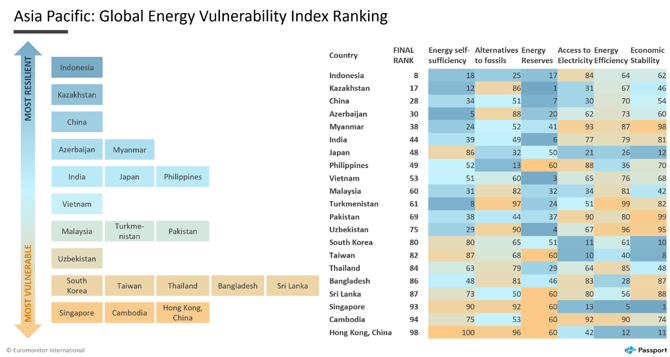In a recent exclusive commentary for GovMedia, Aleksandra Svidler shared her insights on energy vulnerability in Asia Pacific. The topic is part of Euromonitor International’s broader analysis of the globally rising energy pressures amidst the new economic reality.
Historically known for their robust economic growth, many Asian economies are grappling with a complex combination of surging energy demand and aspirations for a sustainable energy future. This article delves into the energy vulnerability of select Asian countries, offering insights into the challenges they face and the opportunities they can seize to enhance their energy security.
Rapid economic and population growth in Asia Pacific drives a surge in energy demand
Energy pressures have been mounting rapidly in developing Asian countries, fuelled by robust economic growth, population expansion, urbanisation, and industrialisation, all leading to a significant surge in energy demand. In 2022, Asia Pacific accounted for over 43% of the global energy consumption, with more than 80% of that demand coming from the developing Asian countries.
By 2030, emerging and developing Asia is forecast to experience roughly 45% real economic growth, with total population reaching nearly 3.9 billion. Considering these projections, increasing energy consumption, combined with limited green investment and persisting infrastructure constraints, presents significant challenges for developing Asian economies in reducing their dependence on fossil fuels and building energy resilience.
High level of self-sufficiency puts Indonesia at the top of Asia’s list
According to Euromonitor International’s Global Energy Vulnerability Index, Indonesia has demonstrated the highest level of energy resilience among Asia Pacific economies. The country enjoys high energy self-sufficiency from the abundant supply of fossil fuels, as well as geothermal energy and biofuels, which play an important role in Indonesia’s energy mix diversification. However, as Indonesia’s energy demand is projected to grow in tandem with its rapidly expanding population and economy, the country will likely be compelled to harness its renewable potential to ensure an affordable and sustainable energy future.

Ample domestic reserves also support the self-sufficiency of several economies in Central Asia, including Kazakhstan, Turkmenistan and Azerbaijan. However, weak energy diversification and low levels of energy efficiency undermine these nations’ long-term resilience and economic stability.
China’s high energy needs pose challenges in reducing its reliance on fossil fuels
Whilst China demonstrated good overall results, ranking among the top third of index performers, the country continues to grapple with significant energy security challenges. For instance, a large proportion of energy-intensive industries, coupled with rapid urbanisation, subdues China’s efforts to improve energy efficiency. Moreover, the country showed moderate results in terms of energy diversification. Whilst China has been actively investing in renewable energy adoption, it is still heavily reliant on fossil fuels.
In 2022, China relied on coal for more than half of its total energy supply
Source: Euromonitor International
Given the scale of the country’s energy needs, bridging the gap between the supply of renewable energy and the rising energy demand is an ongoing challenge and effort in China.
Imports-reliant advanced nations are vulnerable, but have means to withstand the risks
Despite their good scores in energy efficiency and economic stability, Singapore and Hong Kong appear at the opposite end of the index, as small and resource-constrained city states rely heavily on energy imports and face limited renewable energy potential. Nevertheless, high economic affluence, access to financing and advanced technologies can help to withstand potential energy market shocks. To enhance energy security, these countries should focus on maximising the deployment of available renewable sources, such as solar, and diversifying the pool of external energy suppliers. Moreover, promoting energy-efficient solutions, energy conservation and modernisation of power grids can help in managing and reducing energy demand.
Investment in clean energy technologies is highly uneven in Asia, dominated by China
Many developing Asian economies continue to grapple with infrastructure constraints, limited access to capital and high reliance on fossil fuels. Although the region attracts the lion’s share of global green investment, there is a high disparity, with most investments concentrated in China and advanced countries.
In 2022, China accounted for 80% of all newly added renewable energy capacity in Asia Pacific
Source: Euromonitor International from International Renewable Energy Agency
As a result, faced with inadequate investment in innovation and rapidly surging demand for energy, many emerging Asian economies face difficulties in shifting to sustainable energy sources and boosting resilience to energy market shocks.
There are, however, some bright spots in the region. For example, India has ramped up its efforts in clean energy deployment and enjoyed robust investment in solar energy. Policy initiatives, such as the Production Linked Incentive (PLI) scheme, have helped to promote local production of high-efficiency solar photovoltaic modules.
The total installed solar capacity in India has more than tripled over the past five years, exceeding 63GW as of 2022
Source: International Renewable Energy Agency
In the long run, the region’s dynamic landscape also offers large untapped potential for corporate investment in innovative energy solutions. However, to facilitate an equitable energy transition, international cooperation is key in directing more funds to developing regions. Moreover, developing effective legislative and regulatory frameworks, fostering a supportive environment, promoting public and private cooperation, and developing adequate energy infrastructure can help pave the way for a more sustainable and secure energy future in the region.
For further insights and analysis, read Euromonitor International’s full report, New Economic Reality: Rising Energy Pressures, which is part of our report series on the key topic, New Economic Reality.
